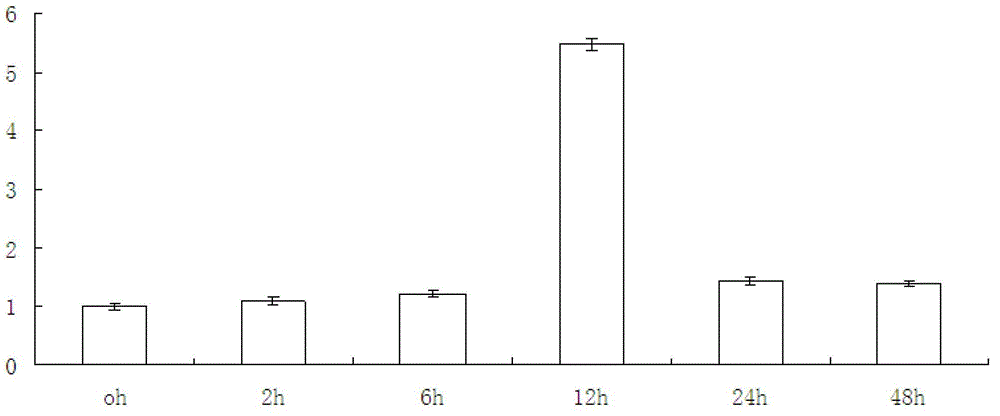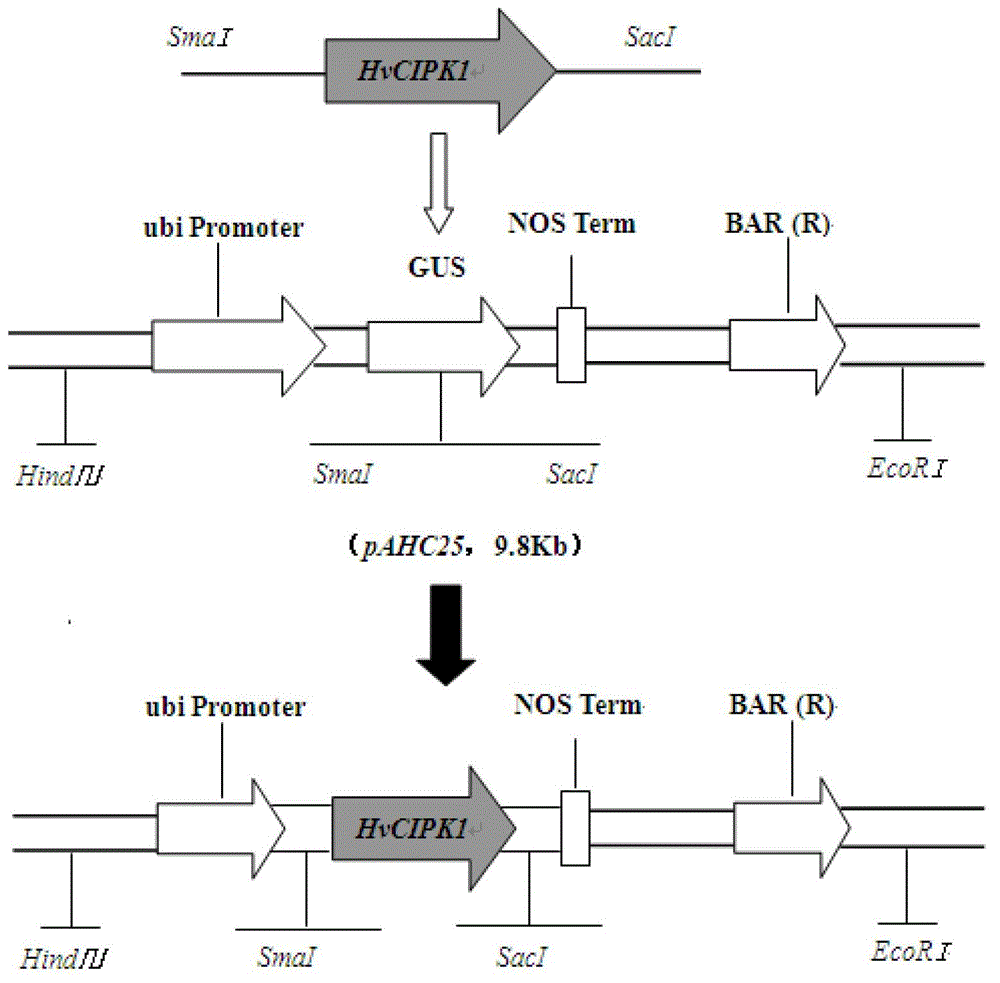Haynaldia villosa calmodulin interacting protein kinase gene and expression vector and application thereof
A protein kinase gene and expression vector technology, applied in the field of genetic engineering, can solve the problems of losing resistance to powdery mildew and rapid change of pathogenic bacteria races, etc.
- Summary
- Abstract
- Description
- Claims
- Application Information
AI Technical Summary
Problems solved by technology
Method used
Image
Examples
Embodiment 1
[0027] Example 1 Cloning of Calmodulin-like Interacting Protein Kinase Gene HvCIPK1
[0028] In the early stage, our laboratory used the cDNA samples induced by powdery mildew to hybridize with Barley 1GeneChip (http: / / www.affymetrix.com / products / arrays / specific / barley.affx) to screen and clone A serine / threonine kinase gene (Hv-S / TPK) induced by white flour in O. pilosa, physically located in the region of Pm21, was overexpressed in the susceptible wheat Yangmai 158 and showed high resistance to white powder Serine / threonine kinase gene Stpk-V, a key member of powdery mildew resistance gene Pm21, confers powdery mildew resistance in wheat, PNAS, 2011, 108 (19): 7727–7732). In order to further clone the powdery mildew resistance-related gene located in the segment of Pm21 of T. villosa, the present invention takes Hv-S / TPK as a starting point to screen the disease-resistant gene analogues around it.
[0029] A large number of studies have shown that there is a certain degree ...
Embodiment 2
[0033] Example 2 Analysis of the expression characteristics of HvCIPK1 after induction by powdery mildew
[0034] Real-time fluorescence quantitative qPCR analysis was performed using the cDNA of the non-induced and induced samples of T. villosa at different times as a template, and the primer pair P3 (TTCGAGGATTGGCCTAATTG (SEQ ID NO.5)) and P4 (GCACTGATGAGCTGATGGAA (SEQ ID NO.6)) , using the housekeeping gene Tubulin as an internal reference. The PCR reaction was amplified on a real-time fluorescent quantitative PCR instrument (MyIQ, Bio-Rad, USA) and fluorescence was detected. The 20 μl PCR reaction system contained 10 μl of 2×SYBR Green PCR MasterMix, 0.4 nmol / μl primers P3 and P4, and 2 μl of reverse transcription product. The amplification parameters were: 95°C for 10 min, then 95°C for 15 s, 58°C for 30 s, and 72°C for 1 min, a total of 40 cycles. After the reaction, the measurement of the melting curve was carried out. Quantitative detection of gene expression levels...
Embodiment 3
[0035] Example 3 Construction of expression vector of HvCIPK1 gene and its transformation Common wheat Yangmai 158
[0036] Using P5 (TCCCCCGGGATGGAGGAAAGGAGGACA (SEQ ID NO.7)) and P6 (ACGCGAGCTCTTACTCCTGTGGCTGCTGT (SEQ ID NO.8)) to construct the HvCIPK1 gene fragment amplified from the cDNA of T. villosa into the transformation vector pAHC-25 (publicly known, refer to Literature: Christensen A H, Quail P H, Ubiquitin promoter-based vectors for high-level expression of selectable and / orscreenable marker genes in monocotyledonous plants. Transgenic Research, 1996, 5:213-218.), double enzyme digestion with SmaI and SacI respectively Carrier pAHC-25 and the target fragment HvCIPK1 gene, replace the GUS gene coding sequence on the pAHC25 vector with HvCIPK1, connect and transform Escherichia coli to obtain a recombinant, and clone the target gene to the downstream of the strong promoter Ubi to obtain the expression vector pAHC-HvCIPK1 . Herbicide resistance gene (Bar gene) as a s...
PUM
 Login to View More
Login to View More Abstract
Description
Claims
Application Information
 Login to View More
Login to View More - R&D
- Intellectual Property
- Life Sciences
- Materials
- Tech Scout
- Unparalleled Data Quality
- Higher Quality Content
- 60% Fewer Hallucinations
Browse by: Latest US Patents, China's latest patents, Technical Efficacy Thesaurus, Application Domain, Technology Topic, Popular Technical Reports.
© 2025 PatSnap. All rights reserved.Legal|Privacy policy|Modern Slavery Act Transparency Statement|Sitemap|About US| Contact US: help@patsnap.com



